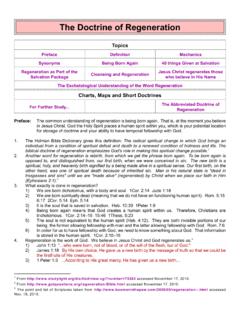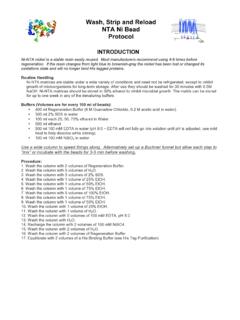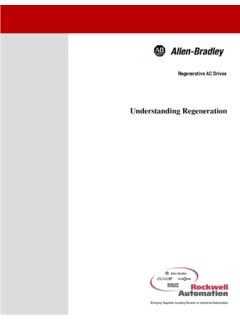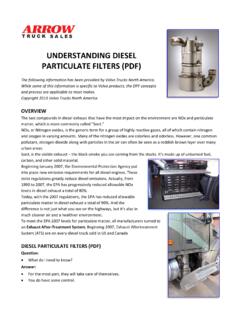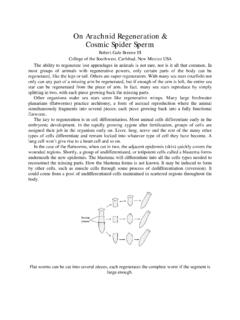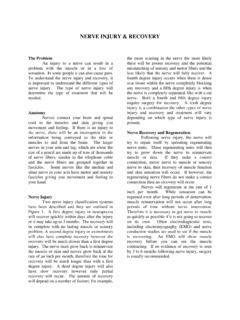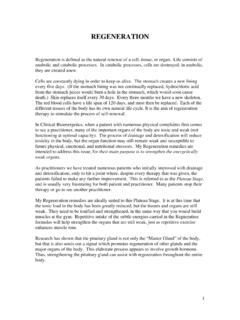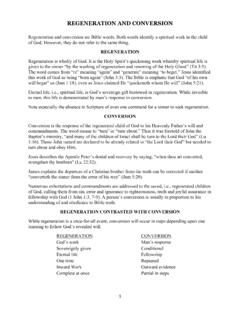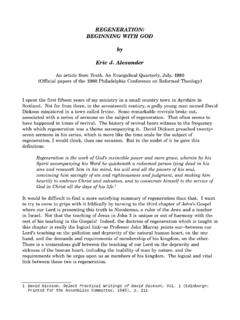Transcription of Tissue Repair: Regeneration and Fibrosis
1 1 Tissue repair : Regeneration and FibrosisPatrice Spitalnik, Outline Control of Cell Proliferation cell cycle Growth Factors Extracellular matrix Cell and Tissue Regeneration repair (scar) Cutaneous wound healing Pathologic repair2 ProliferationBaseline cell populationDifferentiationStem cellsCell deathApoptosisTissue Steady StateStratum granulosumStratum corneumStratum spinosumStratum basaleEpidermis3 Tissue Types Continuously Dividing (labile) Hematopoietic and surface epithelia Stable Liver, kidney, pancreas, smooth muscle, endothelial cells, fibroblasts Permanent Neurons and cardiac muscle4 Signaling of Growth Factor Receptors Autocrine lymphocytes, liver Paracrine macrophages in wound healing Endocrine - hormonesGrowth Factors in Tissue repair Vascular Endothelial growth factor (VEGF) increased vascular permeability Transforming Growth Factor-Beta (TGF-B) Platelet Derived Growth Factor (PDGF) Epidermal Growth Factor (EGF) Fibroblast Growth Factor (FGF)5 VEGF Produced by mesenchymal cells Increases vascular permeability Mitogenic for endothelial cellsTGF- beta Produced by.
2 Platelets and macrophagesMOST IMPORTANT FACTOR IN WOUND HEALING Actions: Monocyte chemotaxis Fibroblast migration and proliferation Angiogenesis and fibronectin synthesis Collagen and ECM: Increased synthesis Decreased degradation by MMP s, increased TIMP s6 PDGF Produced by platelets, macrophages, endothelial cells Chemotactic for neutrophils, macrophages, fibroblasts, smooth muscle cells Stimulates production of MMP s, fibronectin and hyaluronic acid Stimulates angiogenesisEGF Produced by activated macrophages Mitogenic for keratinocytes and fibroblasts Stimulates granulation Tissue formation7 FGF Produced by macrophages, T cells Chemotactic for fibroblasts Mitogenic for fibroblasts and keratinocytes Stimulates keratinocyte migration, angiogensis, wound contration and matrix productionRobbins, Stanley.
3 Basic Pathology7thEdition, Saunders, , VEGF, FGFE pinephrineVasopressinSertoninGH, EPO, IFN, GCSF8 Role of ECM Mechanical Support anchorage, cell migration, cell polarity Cell growth control Maintenance of cell differentiation -Robbins, Stanley. Basic Pathology7thEdition, Saunders, , Stanley. Basic Pathology7thEdition, Saunders, stimulates keratinocyte migration, wound contractureand matrix depostionModel of Leukocyte Transmigration11 Macrophages in inflammation and repair1213 Injury to tissuePatch of fibroblasts with disorganizedECMScarNon-functional tissueFunctional tissueWound repair and RegenerationLungKidneyHeartSkinLiverSple enKey Points How does each Tissue restore itself to prevent scar? Humans lose the ability to prevent scar after fetal life Scar prevents Tissue Regeneration What is the purpose of the scar?
4 14 repair By Connective Tissue Formation of new blood vessels (angiogenesis) Migration and proliferation of fibroblasts Deposition of ECM (scar) Maturation and reorganization of fibrous Tissue (remodeling)Angiogenesis Proteolysis of vessel basement membrane Endothelial cell migration and proliferation Pericyte recruitment15 Growth factor receptors in angiogenesisTwo types of angiogenesis16 Robbins, Stanley. Basic Pathology7thEdition, Saunders, Formation Fibroblast proliferation and migration PDGF, FGF, TGF-beta mainly from macrophages ECM deposition TGF-beta potent agent of fibrosisECM and Tissue Remodeling Outcome of repair : balancebetween synthesis and degradation of matrix MMP sare synthesized by fibroblasts, macrophages, neutrophils, epithelial cells, etc destroy matrix (inactive form) activated by proteases and plasmin and inhibited by TIMP s-synthesized by mesenchymal cells19 Matrix Metalloproteinase RegulationStimulationPDGFEGFIL-1/TNFI nhibitionTGF-betaSteroids12 CellXProcollagenasesProstromelysinsColla genaseStromelysinECMD egraded ECMTIMPs4 XPlasminPlasminogenPlasminogenActivators 3 Activation20 Classic Stages of Wound repair Inflammation until 48 hrs.
5 After injury New Tissue formation 2-10 days after injury Remodeling 1-12 months after repairInjuryResponseAcute InflammationStimulus Promptly DestroyedStimulus Not DestroyedMinimal necrosisExudate resolvedExudate organizedNormal tissueMild burnScarringFibrinoprurulentPericarditis , peritonitisNecrosisFrameworkintactFramew orkdestroyedNormal TissueLobar PneumoniaLabile or stable cellsPermanentcellsScarBacterialabscessS carMyocardialInfarctionPossible Outcomes after Injury21 Regeneration If the connective Tissue framework is intact If the cells are not post-mitotic THEN: Complete restoration of the structure and function of the Tissue is possible22 InjuryResponseAcute InflammationStimulus Promptly DestroyedStimulus Not DestroyedMinimal necrosisExudate resolvedExudate organizedNormal tissueMild burnScarringFibrinoprurulentPericarditis , peritonitisNecrosisFrameworkintactFramew orkdestroyedNormal TissueLobar PneumoniaLabile or stable cellsPermanentcellsScarBacterialabscessS carMyocardialInfarctionPossible Outcomes after Injury2324 InjuryResponseAcute InflammationStimulus Promptly DestroyedStimulus Not DestroyedMinimal necrosisExudate resolvedExudate organizedNormal tissueMild burnScarringFibrinoprurulentPericarditis .
6 PeritonitisNecrosisFrameworkintactFramew orkdestroyedNormal TissueLobar PneumoniaLabile or stable cellsPermanentcellsScarBacterialabscessS carMyocardialInfarctionPossible Outcomes after Injury252627 repair by Fibrosis Angiogenesis Granulation Tissue Migration and proliferation of fibroblasts Deposition of extracellular matrix Organization of collagen remodeling Fibrosis scar formationMacrophages in healing and fibrosis28 Chronic Peptic UlcerFibrosis below the ulcer bed29 Fibrotic response to toxin-mediated injury Poorly understood:-Liver Hepatitis B,C-Pulmonary fibrosisScarring in the Liver Healing by Fibrosis after inflammation TGF beta implicated in excessive collagen formation30 Cirrhosis31 Nature Vol.
7 453;15 May 2008 CutaneousWound HealingClassic Stages of Wound repair Inflammation until 48 hrs. after injury New Tissue formation 2-10 days after injury Remodeling 1-12 months after repair32 Overview of CutaneousWound Healing A defect in the skin occurs Fibrin fills in defect scab forms Epithelial Regeneration beneath scab Granulation Tissue angiogenesis Wound contraction Collagen remodeling33 Cell Migrations in Wound Healing Plateletsform a blood clot and secrete fibronectin (FN), PDGF and TGF-beta Neutrophilsarrive within minutes Macrophagesmove in as part of granulation Tissue and secrete fibronectin Keratinocytesor other epithelial cells detach from the basement membrane at wound edge and migrate on fibronectin rich matrix across wound to fill in defect (cells switch receptors from those for BM to FN receptors)34 New England Journal of Med 341:738-746, 1999 New England Journal of Med 341.
8 738-746, 199935 Healing by Primary Intention Surgical incision Edges easily joined together Small amount of granulation Tissue Little Fibrosis Wound strength 70-80% of normal by 3 months36 Healing by Second Intention Large wound, may be infected Edges notbrought close together Large amount of granulation Tissue Scar formation and contracture37 Inhibition of repair Infection with inadequate nutrition (Vitamin C is essential for collagen) Glucocorticoids inhibit inflammation with decreased wound strength and less Fibrosis . Poor perfusion due to diabetes or atherosclerosis. Foreign bodies left in the wound. Chronic inflammation leads to excess, disabling Fibrosis as in rheumatoid arthritis, pulmonary Fibrosis and Foot UlcerCase #1 A 52 year old woman has had fairly well controlled type 2 diabetes mellitus for the past 20 years.
9 In the last three months, she has noticed a non-healing ulcer on her heel. She asks you what can be done to make it heal New Therapy Application of VEGF alone to wounds in an animal model of diabetes (wound repair is dysregulated in DM) can normalize healing A 63 year old male has had Type 2 diabetes mellitus for the past 10 years. He requires insulin. He presents to you with the complaint of a painless sore on the sole of his foot directly beneath a metatarsal head. He asks why his foot has difficulty Foot UlcerCase #240 Inhibition of repair Foreign body in wound41 Foreign body - suture42 Abnormal repair Processes Inadequate scar formation - dehiscence, ulceration Excessive scar formation keloids Contracture exaggeration of normal process (soles, palms, thorax) especially with serious burns434445 Nature Vol.
10 453;15 May 200846 Nature Vol. 453;15 May 2008










